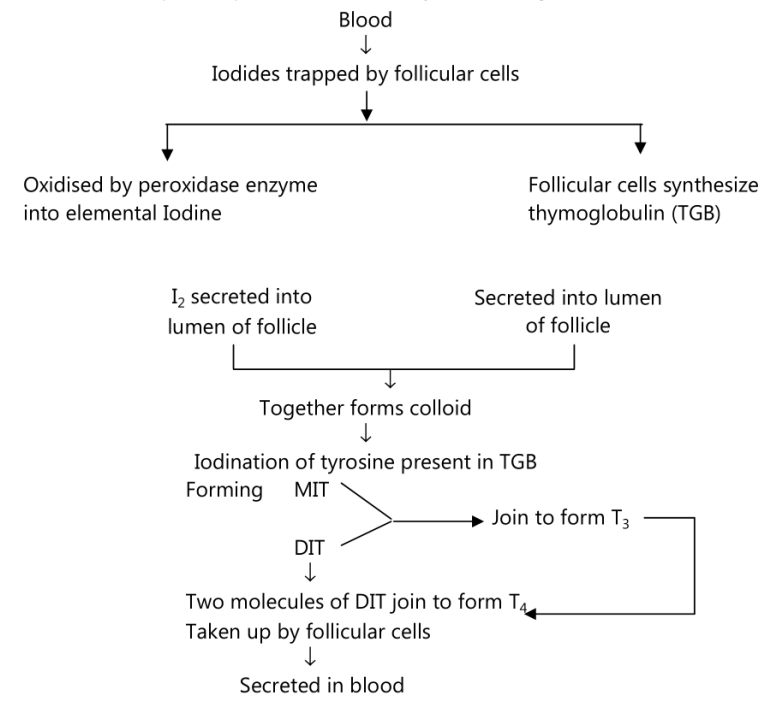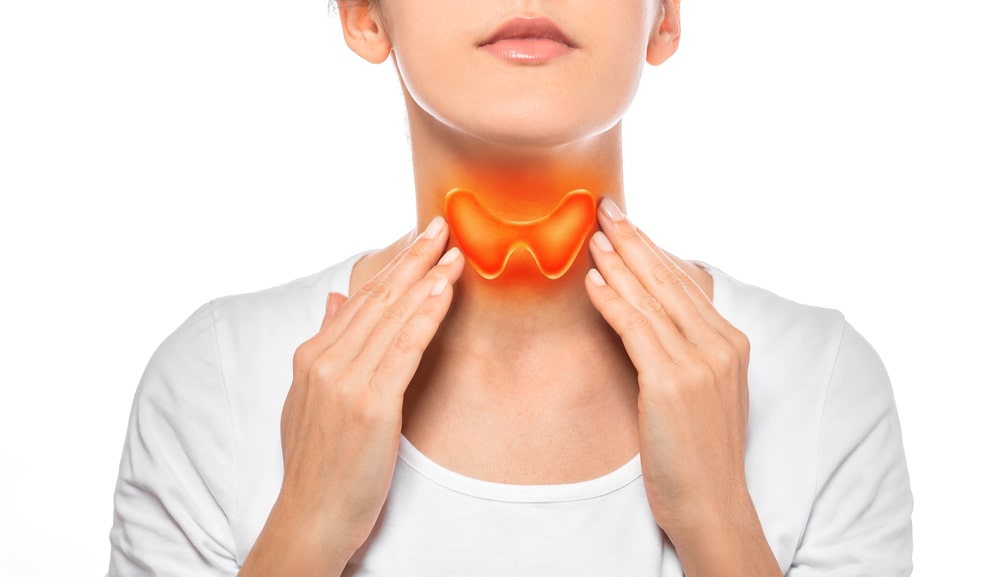It is one of the largest endocrine glands of the body. It originates in the floor of the pharynx as an epithelial thickening. The thickening grows outward from the pharynx and loses its connection with the gastrointestinal tract It further develops as two lobes laterally to the trachea, below the larynx. The two lobes are connected by a thin band of tissue on the anterior side called as the isthmus. The gland is highly vascularized and receives a high blood supply. The anatomy of thyroid Gland gland is composed of hollow spherical follicles lined by cuboidal cells. The shape of follicular cells varies with their activity, they become taller and more columnar when actively secreting and flatten when inactive. The follicular cells secrete hormones, thyroxin (T4) and Triiodothyronine (T3). A few cells lie between follicles and are called as par follicular cells which secrete the hormone, calcitonin.

Synthesis of Thyroid Hormones
Iodine absorbed from the gastrointestinal tract appears in the blood as inorganic iodide. The follicular cells of the thyroid gland take up this iodine (Trapping of lodine). The iodide ions are oxidized in the follicular cells and the elemental iodine formed is secreted into the lumen of the follicle. The follicular cells synthesize thyroglobulin (TGB) which contains tyrosine as one of the amino acids. Follicular cells secrete this thyroglobulin (TGB) into the lumen of the follicle. The lumen containing TGB and iodine is called as a colloid. In a colloid, the lodine attaches to tyrosine amino acids of TGB. The binding of one iodine yields monoiodotyrosine (MIT) and the second iodination gives iodothyronine (DIT). Further MIT and DIT join to form Triiodothyronine (T3) and DIT join to form thyroxin. The colloid containing these hormones is then taken up by the follicular cells by Pinocytosis. On stimulation, by TSH these hormones are released by diffusion through the membrane into the bloodstream. In blood, the thyroid hormones are bound to plasma protein known as Thyroid Binding Globulin (TBG).

Thyroid hormones significantly affect the metabolic activities of the body. They influence mainly the cell metabolism by controlling activities of oxidizing enzymes within the mitochondria. The cells use more oxygen to produce ATP; more heat is produced and body temperature rises. This heat is useful for the regulation of normal body temperature. Thyroid hormones increase the utilization of glucose for ATP production and stimulate protein synthesis and enhance lipolysis. In conjunction with HGH and insulin, these hormones participate in the body’s growth.
Thyroid hormones enhance the actions of the catecholamine occurring through receptors (ß receptors) such as an increase in heart rate, and blood pressure. The secretory activity of the thyroid gland is governed by the level of iodine and negative feedback mechanism involving hypothalamic thyrotrophic releasing hormone and then TSH secretion by the anterior lobe of the pituitary gland.
Calcitonin secreted by par follicular cells of the thyroid gland helps in regulating calcium (Ca++) and phosphate (PO—4 ) in blood. It decreases the level of these ions in blood by enhancing their uptake by bones. Blood calcium level directly controls the secretion of calcitonin by the negative feedback mechanism.
Disorders of the Thyroid Gland
The disorders (Hyposecretion or hypersecretion) of the thyroid gland result in a variety of pathological conditions depending on the age group of the individual. At a younger age, the hyposecretion leads to failure in the development of the skeleton and brain; this results in cretinism. The cretins thus show dwarfism and mental retardation. There is also retardation of sexual development.
In adults, hyposecretion leads to myxedema. The condition is characterized by puffiness of the face and eyelids, and a swelling of the tongue and larynx. The individual has a low basal metabolic rate and reduced body temperature. The mental activity is generally sluggish and retarded. The condition is more common in women than men.
Thyrotoxicosis is a condition in which excess of thyroid hormones act on body tissues. Hyperthyroidism is a form of Thyrotoxicosis. The condition is characterized by an increase in basal metabolic rate, body temperature, heart rate (tachycardia), appetite, and nervousness. The most common form of hyperthyroidism is Grave’s disease, the person produces antibodies that mimic the action of TSH, under the influence of which the thyroid gland enlarges and produces a large number of thyroid hormones. Grave’s patients sometimes show edema behind the eyeballs and hence, have protruding eyeballs. It is referred to as exophthalmos.
Yet another disorder referred as goiter is a simple enlargement of the thyroid gland. The dietary deficiency of iodine results in a decreased level of thyroid hormones in the blood. This results in increased secretion of TSH, under the influence of which the thyroid gland enlarges.
Make sure you also check our other amazing Article on: Functions Of The Urinary System
